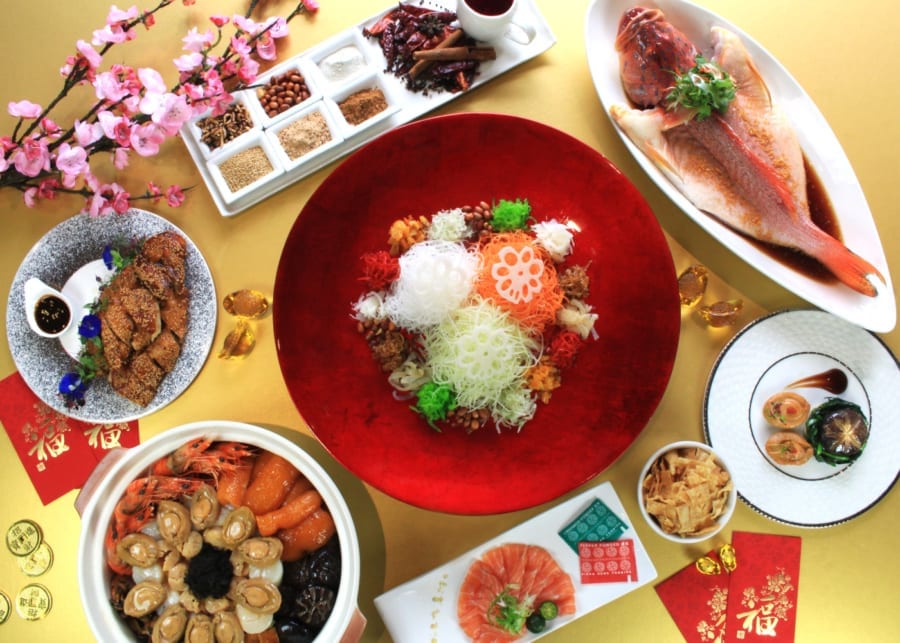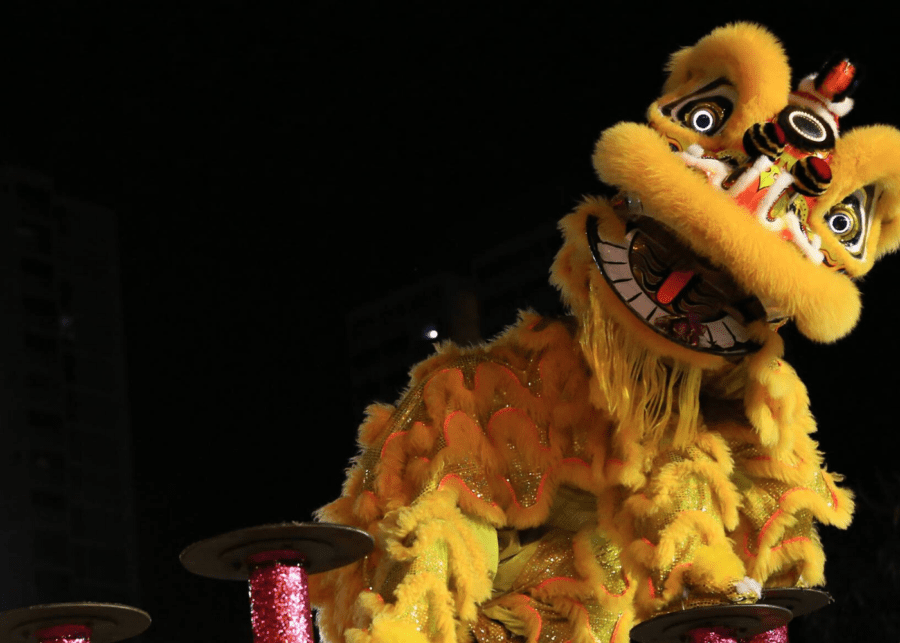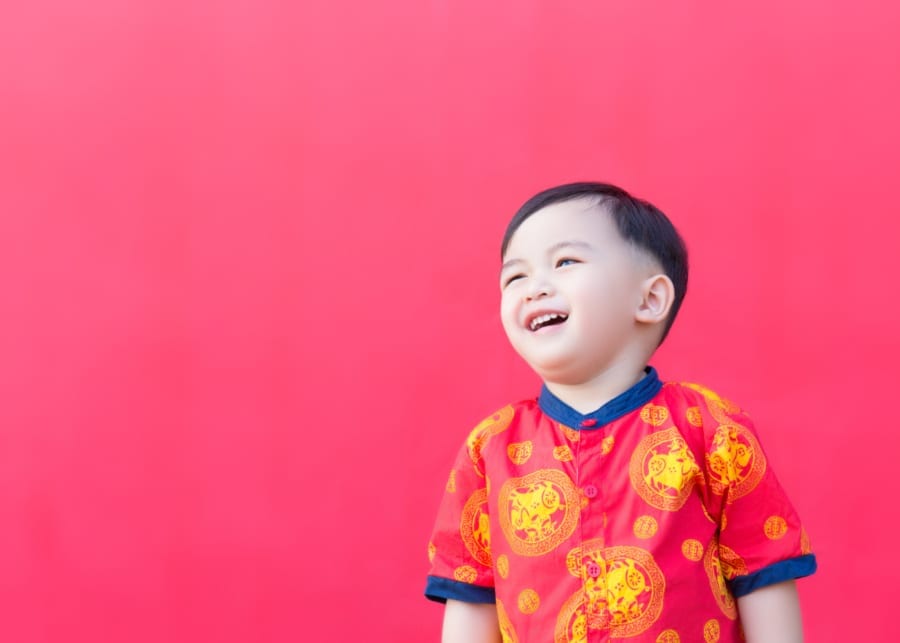
If you don't know your ang bao from your lo hei then you're going to need our guide to all the traditions of Chinese New Year in Singapore…
Chinese New Year is here! If CNY festivities aren’t something you traditionally celebrate, or you are a newbie here in Singapore, then you might need a quick lesson in ang bao etiquette, instructions on how you should be tossing your lo hei, and the answers to why you feel suddenly compelled to eat tarts filled with pineapple at this time of the year. This year, festivities begin on Saturday, 10 February 2024, starting a Year of the Dragon (more on this below). Find out more if it’s a public holiday as well as other holidays to look out for this year!
Read on for our beginners’ guide to Chinese New Year traditions!
Guide to Celebrating Chinese New Year in Singapore
Click below to read more:
The Chinese New Year Lingo
Traditional food during Chinese New Year
Chinese New Year Traditions
The Chinese New Year lingo in Singapore
Get up to speed with these terms that will be bandied around this festive period!

1. Gong Xi Fa Cai
First, make sure you find out how to pronounce gong xi fa cai (Happy New Year). You may also hear Kung Hei Fat Choy, the same greeting in Cantonese.
2. Huat
Keep your ears out for this word, which is everywhere now, and for good reason. It translates to prosperity or getting rich – very important for an auspicious year ahead. “Huat ah!”
3. Ang bao (or pao)
AKA red packets to many of us. Giving an ang pao is a Chinese New Year tradition to share your own blessings. While there are no hard and fast rules when it comes to how much cash you should be filling the packet with, there are customs to be followed:
- Red is the preferred colour for packets as it is regarded as a symbol of happiness and good luck.
- It is impolite to open a red packet in front of the person who gives it to you.
- The amount of money in the envelope usually contains a digit that ends with an even number. Odd-numbered packets are associated with funerals!
- Money should not be given in fours, nor should the number four appear in the amount. In Mandarin and Cantonese, the word “four” is similar to the word “death” and is considered unlucky.
- If you have not tied the knot yet, you won’t be expected to give red packets.
- Generally, once you are married, you will no longer receive red packets other than from your parents and grandparents.
- Oranges and auspicious sayings are usually offered in exchange for ang baos as an extra sweetener to the rellies. Check out a list of sayings you should listen for (or try them yourself!)
Note: Nowadays, Singapore is encouraging people to gift e-ang baos to reduce queues at the bank (plus, it’s better for the environment!). This began as a result of the pandemic. If you still want to stick with the physical red packets, you’ll need to book an online appointment with your bank or queue up at the ATM to get your new notes.
4. Nian
Many Chinese New Year traditions were created to chase away Nian, and you will see and hear this name a lot during the New Year celebrations. But who or what is Nian? According to Chinese mythology, a Nian is a terrifying beast that lives under the sea or in the mountains. On Chinese New Year’s Eve, it comes out of hiding to attack people, munch on animals and devour children. Kinda makes the Boogie Man seem like a puppy dog in comparison.
Traditional food at Chinese New Year in Singapore
What’s a celebration without some kind of festive indulgence. These are THE foods to look out for this Chinese New Year.

1. Lo Hei/Yusheng /Prosperity toss
You’ll see all three of these names being bandied about at reunion dinners and supermarkets all over Singapore. Have you ever wondered what lo hei means, though? These words refer to a Teochew-style raw fish salad, which includes raw fish, shredded veggies and a plethora of sauces in a dish, meant to be shared and tossed together while you recite auspicious sayings for the New Year. The higher the toss, the better your prospects for the year ahead.
2. Pen Cai
Another popular one at reunion dinners, pen cai (or poon choi), is a traditional Cantonese dish composed of many layers of luxury ingredients. And the more luxurious, the better! You’ll commonly find abalone, sea cucumber, scallops, fish maw, and more! Note. It’s usually a pricey dish on the reunion dinner menu. Served in a clay pot or equivalent, the dish is very tasty and meant for communal dining. You can also enjoy this festive treat at home, with many restaurants offering pen cai as part of their takeaway menu.
3. Fish
It is traditional to serve a whole fish on Chinese New Year’s Eve but then save half of it for the New Year’s Day celebrations. The Mandarin and Cantonese word for fish (鱼 yú) resembles the word for ‘plenty’. By saving half the fishy fella for another time, it symbolises abundance for the future. But the CNY fish dish comes with its own rules:
- Buy the freshest fish you can possibly reel in for yourself.
- The fish must have clear eyes and not have a fishy odour.
- Your fishy friend should be cooked and served whole, with the head and tail intact. The body of the fish represents family unity and togetherness.
- If you are serving your fish to guests, as a sign of welcome, place it on the table facing them.
- Only tuck into the fish once the person who faces the fish’s head eats first.
- The fish shouldn’t be moved during the meal.
- Diners who face the head and the tail end of the fish should have a drink together. This ensures a big dose of good luck!
4. Love letters / kueh kapit

Don’t be alarmed when you hear your kiddos telling you they had a heap of love letters given to them in school. These are of the edible kind, not the romantic kind. These delectable little wafers are a popular snack during CNY and were historically a way for lovers to communicate back in the day secretly. Once the message was delivered, it would then be eaten, and the edible words would be consigned to the lover’s heart forevermore. It’s a way more romantic version of Snapchat!
5. Kueh bangkit

These tapioca cookies are traditional Nyonya cookies that were historically used as altar offerings to ancestors to spend in their afterlife. Hence them traditionally being in the shape of currency from ancient China. Animal and flower-shaped versions are popular today, with each having its own symbolic meaning:
- Goldfish – prosperity
- Butterfly – afterlife
- Peonies – faith
- Chrysanthemums – fortune
6. Bak kwa
This air-dried meat delicacy is a super popular Chinese New Year tradition here in Singapore and for deliciously good reason! Order online during Chinese New Year to bag yourself this treat. It’s also a popular gift during the festive season for friends and family for its reputation as a luxury food and its deep red colour, symbolising good luck.
7. Pineapple tarts/ong lai

These yummy small parcels of pastry with a pineapple filling bring good luck and prosperity to the house. Ong lai translates to ‘prosperity has arrived’.
8. Tangerines and mandarin oranges

Tangerines represent wealth, and oranges symbolise good luck, so they make a popular Chinese New Year gift amongst friends. Make sure to offer these fruits with both hands! Also, don’t be alarmed if your prezzie gets knocked back the first time around… It is polite for the recipient to refuse initially! The final day of Chinese New Year is also considered a time ripe for love. All the single ladies (cue Beyoncé) write their phone numbers on mandarins and toss them into the river. The single men, on the other hand, will be waiting eagerly downstream to collect the fruits and eat them. The sweetest fruit the man tries is the lucky lady he should be dating for a lifetime of luck together! Much nicer than Tinder, we think.
9. Pomelos
This massive Asian fruit shares its name with words similar to status and prosperity in Cantonese. It also represents good health, family and fertility. All that from a fruit!
10. Tray of Togetherness
Also known as Eight Treasures Box, this is a childhood favourite for any kid who’s ever been dragged along to family reunions at Chinese New Year. First, greet the relatives with oranges, collect the cash offerings, and then raid the Candy Box! The boxes can be made from any material, are usually hexagonal or octagonal (eight sides = extra lucky), and are stocked with all kinds of treats. Dried fruit, melon seeds, pistachios and candy are the usual winners. Once the box is emptied, the host will refill it. Be sure to keep an eye on how much sugar your kids are stashing when they think you’re not looking!
Chinese New Year Traditions in Singapore

1. Ancestor worship and reunion dinner
The festivities kick off with ancestor worship – family members will make an offering to ancestors by offering food, fruits, flowers and tea. Once the ancestors have been honoured, it’s time for the annual feast, where the whole family gets together to celebrate their love and respect for each other and reaffirm the bonds of unity. This gastronomic dinner has tons of food as the Chinese believe that it will bring the family material wealth in the new year ahead. Here are our favourite reunion dinners to enjoy out or in the comfort of your home!
2. Firecrackers
Chinese New Year is all about colour and noise. Firecrackers are lit to ward off the advances of the terrible monster Nian and other evil spirits. Firecrackers aren’t allowed in Singapore anymore, but you’ll still see cardboard recreations strung up around people’s houses.
3. The Lion Dance
There are loads of fun things to do with the family over CNY, but one of our favourite Chinese New Year traditions has to be catching a lion dance. Lion dancers rove the neighbourhoods around this time and are hired to perform in front of houses and establishments to chase away ghosts, evil spirits and bad luck and welcome in prosperity, while accompanied by gongs, cymbals and drums to provide extra scare tactics against nasty ol’ Nian. Need to brush up on your lion dance etiquette? We love this cute beginner’s guide to lion dances by Ireny Draws.
4. Roving God of Wealth
As a mythical figure in Chinese folklore and Taoism, the God of Wealth has been depicted in historical figures combined with religious gods, goddesses, devils, immortals, demons and spirits in Chinese mythology. You will usually see one roving around shopping malls, lion dances, condos and public areas with a pot of gold (chocolate) coins or a basket of sweets over Chinese New Year.
5. Chinese Zodiac
Ever wondered how the order in the Chinese zodiac came about? According to ancient folklore, the Jade Emperor (an important god in Chinese religion) organised a race and invited animals from all over the world. As a reward for showing up, he named each animal after each year in the zodiac. The zodiac would then be based on the order in which these animals finished in the legendary race. Last year was the “Year of the Rabbit“, number four out of 12 in the zodiac. This year we will be welcoming in number five, the Dragon! This Chinese zodiac sign symbolises abundance. Those born in the Year of the Dragon are said to be intelligent, sly and loyal.
6. The colour red

Heavily associated with happiness and good fortune, the colour red can be traced back thousands of years, when fire was worshipped as a provider of warmth and safety. It’s also believed to ward off nasty evil spirits, and Nian is especially terrified of red! As a Chinese New Year tradition, many households decorate their homes with red paper cut-outs, red couplets and the red character 福 (fu = fortune) during Chinese New Year. Red clothes, right down to red undies, are also a must! Don’t let the kids miss out; check out our favourite CNY outfits for the little ones!
7. Hide the sharp stuff and keep those locks dry!
Stash away the kitchen knives and scissors, people! Chinese superstition is huge when it comes to sharp stuff during the Chinese New Year celebration period. Sharp objects are a deterrent in bringing good luck your way, so no trips to the hairdressers during the festivities either (unless you want your chances of good fortune snipped away!). And whilst we are on the topic of hair, the Chinese word for hair is “fa” as in “fa cai” or “to prosper” meaning if you give that hair a scrub, you’re flushing your fortune down the pipes. Don’t worry about skipping this one (we’ve been skipping for years), but if you’re willing to give it a try and you find some money in your locks, do let us know!
8. Spring cleaning
Get your cobwebs tackled, your dusty corners conquered, and your house in spick and span condition on the 28th day of the last month of the old year before Chinese New Year. The spring clean symbolises sweeping away any traces of bad luck at this time, but sweeping the house during Lunar New Year is a massive no-no: it is important to collect the dust bunnies in a corner to keep the newly arrived good luck inside the home until at least the fifth day of the New Year. Fun fact: did you know that bamboo leaves are traditionally used to sweep and clean the house? Some folks believe using bamboo helps you chase out evil spirits when cleaning the house.
Gong xi fa cai, everyone!
